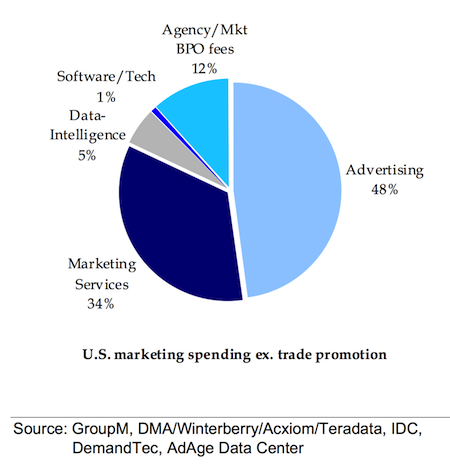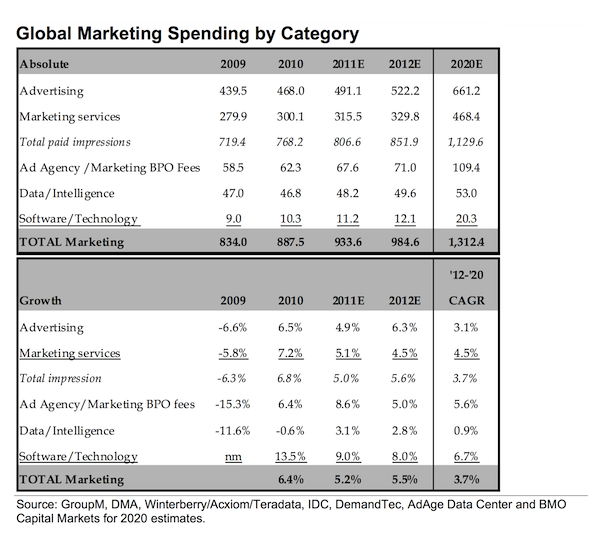Marketers will spend about $1 trillion this year on external costs: everything from advertising of every kind, marketing services such as direct mail and lead generation, agency fees, data and intelligence such as market research, and — at the very bottom of the stack — software and technology.
In 2012, marketing technology will account for only 1% of marketing spend.
According to a recent report by research analyst Dan Salmon, the amount spent on software and technology globally this year will be around $12.1 billion out of the $984.6 billion spent on all external marketing costs. (Dan’s report does not cover in-house marketing expenses — primarily staff — such as creative personnel, data analysts, “marketing IT departments” or the CMO.)
My initial reaction was: the revolution will be rounded down?
For its 1%, marketing technology has disproportionately disrupted marketing-as-we-knew-it. Given the tremendous impact technology has had on the remaking of marketing, it’s hard not to feel a little cognitive dissonance around the notion that it’s captured such a tiny portion of the budget.
However, this number is a little misleading because, in fact, technology has disrupted and innovated many of those other categories. Within advertising, it’s digital advertising that is growing at the rate of 18% this year. GroupM just released an updated forecast predicting $99 billion will be spent on digital advertising this year (out of $506 billion spent on all advertising). Gartner just released a report predicting $8.8 billion will be spent on social media advertising alone this year.
The very channels of this advertising are a function of technological innovation.
Similarly, marketing services, agency fees, data and intelligence services, etc., are all leveraging new technologies in their infrastructure and operations. Companies such as Axciom, comScore, Compete, Epsilon, Experian, etc., instantly leap to mind.
Last but not least, these numbers not only leave out marketer’s in-house spend on technology-centric staff, they also leave out the contributions of the IT department. While the shift in spend between marketing and IT is in flux, varying significantly from one company to another, there’s clearly a major portion of IT investment in technology-powered “customer experiences” that are moving under marketing’s umbrella.
But there are two other ways to look at this:
1. Technology is bringing efficiency to marketing. For a fraction of media spend, smart technology can have an outsized impact on marketing outcomes. I’ve seen this first-hand in the conversion optimization space, where a small investment in targeted landing pages with A/B testing can have double-digit lift on lead generation or e-commerce transaction metrics. To achieve that net increase with just more advertising would require a massive increase in budget.
The relative cost efficiency of technology provides a sharp contrast to just how inefficient marketing spend has been in the past.
2. The opportunity to move marketing spend from traditional buckets to technology-driven ones is still huge. For all that has happened so quickly, we must acknowledge that we are still in the early phases for a multi-decade transformation of marketing. There have been many great marketing technology wins, but they’re dwarfed by the potential for what can be won in the future.
After all, as it is elsewhere, that 1% wields incredible power and influence.
Here’s the more detailed breakdown of spend numbers — and growth trends — from Dan’s report:





Hi Scott,
I guess ‘marketing technology’ is as you rightly allude, not still owned within ‘marketing budgets’ and seems investments in marketing technologies are accounted for under overall enterprise IT spends (owned by business operations/ IT).
Second, much of marketing technology is being ‘served into’ the enterprise either as SaaS or bundled as enablers of the vendor’s marketing services (example: print management or premedia agencies offering workflow automation as a bundle with creative or production services).
It seems marketing service providers across the spectrum – advertising, BTL, packaging, digital marketing, print management etc., are absorbing the investments in marketing technologies and so, it doesn’t reflect in the expenditure of brand owners and their marketing budgets.
Best regards
DJ Balodi
Hi Scott,
You list many sources for the global marketing spend pie-chart. I’m really interested in this breakdown of marketing spend by type of service. Could you tell me which sources are really needed to put it together. Also if any of the sources break categories down further (I’m thinking of categories such as ‘creative services’, ‘campaign planning’, ‘excecution and buying’…).
Also, do you have view of the 2013 numbers for the pie chart?
Best regards,
Jack Waldron